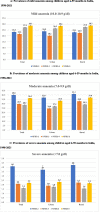Key drivers of reversal of trend in childhood anaemia in India: evidence from Indian demographic and health surveys, 2016-21
- PMID: 37596564
- PMCID: PMC10436448
- DOI: 10.1186/s12889-023-16398-w
Key drivers of reversal of trend in childhood anaemia in India: evidence from Indian demographic and health surveys, 2016-21
Abstract
Aim: Recent National Family Health Survey results portray striking improvements in most population and health indicators, including fertility, family planning, maternal and child health, gender treatment, household environments, and health insurance coverage of the Pradhan Mantri Jan Arogya Yojana (PM-JAY), with all India resonance. However, the prevalence of any anaemia (< 11 g/dl) among children under age five has exhibited a reversed trajectory in recent years. Therefore, the present study explores key drivers of the reversal of the trend in the prevalence of childhood anaemia between 2015 and2021.
Methods: Data of four rounds of the National Family Health Survey (NFHS) were used to show the overall trend of anaemia among children. However, for the analysis of key drivers of the reversal trend of childhood anaemia, only the recent two rounds (NFHS-4 & NFHS-5) were used. Descriptive, bivariate multivariable analysis and Fairlie decomposition model were used to explore the drivers of the reversal of the trend in childhood anaemia.
Results: During the past two decades, India has seen a decline in the prevalence of childhood anaemia (NFHS-2 to NFHS-4). However, a reversal of trend was observed recently. The prevalence of anaemia among children aged 6-59 months increased from 59 percent in NFHS-4 to 67 percent in NFHS-5. In addition, the prevalence of mild anaemia increased from 23.3 percent in NFHS-2 to 28.7 percent in NFHS-5. However, the prevalence of moderate and severe anaemia declined considerably from NFHS-2 (40 percent and 4.1 percent) to NFHS-4 (28.7 percent and 1.6 percent), but showed an increase in the prevalence in NFHS-5 (36.3 percent and 2.2 percent). Among others, mothers' educational attainment, anaemia status and socio-economic status emerge as the key drivers of the change in the prevalence of childhood anaemia.
Conclusion: These findings may have vital implications for the ongoing Anaemia Mukt Bharat Programme, one of the government's dream projects in India.
Keywords: Childhood anaemia; India; Key drivers; Reversal of trends; Under-five children.
© 2023. BioMed Central Ltd., part of Springer Nature.
Conflict of interest statement
The authors declare that they have no conflict of interest.
Figures



Similar articles
-
Trends and predictors of severe and moderate anaemia among children aged 6-59 months in India: an analysis of three rounds of National Family Health Survey (NFHS) data.BMC Public Health. 2024 Oct 14;24(1):2824. doi: 10.1186/s12889-024-20328-9. BMC Public Health. 2024. PMID: 39402527 Free PMC article.
-
Prevalence of anaemia among 6- to 59-month-old children in India: the latest picture through the NFHS-4.J Biosoc Sci. 2020 Jan;52(1):97-107. doi: 10.1017/S0021932019000294. Epub 2019 May 20. J Biosoc Sci. 2020. PMID: 31104639
-
To what extent classic socio-economic determinants explain trends of anaemia in tribal and non-tribal women of reproductive age in India? Findings from four National Family Heath Surveys (1998-2021).BMC Public Health. 2023 May 11;23(1):856. doi: 10.1186/s12889-023-15838-x. BMC Public Health. 2023. PMID: 37170116 Free PMC article.
-
How the findings of national family health survey-3 can act as a trigger for improving the status of anemic mothers and undernourished children in India: a review.Indian J Med Sci. 2007 Sep;61(9):535-44. Indian J Med Sci. 2007. PMID: 17785892 Review.
-
Trends in prevalence and determinants of severe and moderate anaemia among women of reproductive age during the last 15 years in India.PLoS One. 2023 Jun 1;18(6):e0286464. doi: 10.1371/journal.pone.0286464. eCollection 2023. PLoS One. 2023. PMID: 37262022 Free PMC article. Review.
Cited by
-
Relationship between adolescent anemia and school attendance observed during a nationally representative survey in India.Commun Med (Lond). 2024 Jun 12;4(1):112. doi: 10.1038/s43856-024-00533-8. Commun Med (Lond). 2024. PMID: 38866923 Free PMC article.
-
The impact of Pradhan Mantri Matru Vandana Yojna scheme on access to services among mothers and children and their improved health and nutritional outcomes.Front Nutr. 2025 Jan 8;11:1513815. doi: 10.3389/fnut.2024.1513815. eCollection 2024. Front Nutr. 2025. PMID: 39845916 Free PMC article. No abstract available.
-
Co-Occurrences of Forms of Child Undernutrition in India: Insights from the National Family Health Survey.Nutrients. 2025 Mar 11;17(6):977. doi: 10.3390/nu17060977. Nutrients. 2025. PMID: 40290049 Free PMC article.
-
Enhancing anemia diagnostics and accessibility in India: a policy recommendation for effective anemia management.Front Health Serv. 2025 May 15;5:1529094. doi: 10.3389/frhs.2025.1529094. eCollection 2025. Front Health Serv. 2025. PMID: 40444221 Free PMC article.
-
Inequality in Childhood Anaemia Among Indian Hindus (2006-2021): A Comparison of Scheduled Castes and Tribes with Upper Castes.J Racial Ethn Health Disparities. 2025 Jul 10. doi: 10.1007/s40615-025-02535-1. Online ahead of print. J Racial Ethn Health Disparities. 2025. PMID: 40638033
References
-
- World Health Organization (WHO). Anaemia. 2021. https://www.who.int/health-topics/anaemia#tab=tab_1.
-
- WHO. Prevalence of anaemia in children aged 6–59 months. 2021. https://www.who.int/data/gho/indicator-metadata-registry/imr-details/4801.
-
- WHO. Prevalence of anaemia in women of reproductive age (aged 15-49). 2021. https://www.who.int/data/gho/data/indicators/indicator-details/GHO/preva...-(-).
MeSH terms
LinkOut - more resources
Full Text Sources
Medical
Miscellaneous

